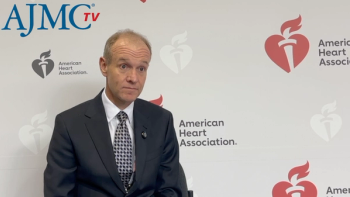
Panel: We Must Invest in Communities With HIV, Respond to Their Needs, and Leave No One Behind
This year marks the 23rd International AIDS Conference, AIDS 2020, and the 30th anniversary of the first conference held in San Francisco in 1990 amid the first few years of the AIDS epidemic. The theme for this year’s conference is “Resilience,” and that certainly holds true for this global undertaking, which is happening in a virtual setting for the first time in the conference’s history due to the current coronavirus disease 2019 pandemic.
This year marks the 23rd International AIDS Conference, AIDS 2020, and the 30th anniversary of the first conference held in San Francisco in 1990 amid the first few years of the AIDS epidemic. The theme for this year’s conference is “Resilience,” and that certainly holds true for this global undertaking, which is happening in a virtual setting for the first time in the conference’s history due to the current coronavirus disease 2019 (COVID-19) pandemic.
One of the first sessions today, day 1 of the conference, was “2025 AIDS Targets: Setting The Next Generation of Goals for the Global AIDS Response.” Started off by Shannon Hader, deputy executive director of programme, UNAIDS, this group presentation focused on the next generation of goals for the global AIDS response.
“So, the 2020 targets set out in the 2016 Political Declaration on HIV/AIDS will soon elapse, as will the global AIDS strategy shortly after,” Hader pointed out. “And although we do collectively have the global targets set to 2030 under the sustainable development goals [SDGs], we don’t have the midpoint targets to guide the global AIDS response on our way to reaching them. An updated set of programmatic targets for 2025 is needed to keep us on track for 2030.”
This process to set these midpoint goals for 2020 began in October 2018 and will continue through midyear 2021, and it has 3 main objectives:
- Setting targets for 2025
- Estimating the epidemiological impact of reaching the targets for 2021 through 2030
- Calculating the estimated price tag to reach these targets for low- and middle-income countries for 2021 through 2030
The session focused on the strategic planning that has been made toward these goals as it informs the next-generation UNAIDS strategy, especially with its focus on the roles of
- Reducing stigma and discrimination
- Providing access to an improved legal environment and social justice
- Allowing for gender equality
“Regarding integration,” Hader said,” attention for people-centered services is key, and integration can be delivered in a way that improves those services to individuals.”
Hader was joined in the session by:
- Ambassador Deborah Birx, MD, US global AIDS coordinator, US special representative for global health diplomacy, and response coordinator for the White House’s Coronavirus Task Force;
- Paul Delay, co-chair of the steering committee on 2025 AIDS Targets;
- John Stover, vice president and founder of Avenir Health;
- Wafaa El-Sadr, MD, MPH, MPA, director of ICAP and of the Center of Infectious Disease/Epidemiologic Research at the Mailman School of Public Health at Columbia University; and
- Quarraisha Abdool Karim, PhD, associate scientific director of the Center for AIDS Program Research in South Africa (CAPRISA).
Where do we need to be in 2025, and how will we get there? The ramifications to this 2-part question were evident throughout the hour-long presentation on the 2025 goals’ vision and opportunities to achieve that vision.
Birx highlighted how 2020 targets in the global fight against AIDS have not been reached and we are currently not projected to reach the goals that the President’s Emergency Plan for AIDS Relief has set for 2030.
“Progress is not equal everywhere. We see this laid bare with COVID-19,” Birx stated. “Community voices must really be forefront in any messaging we have. This is what UNAIDS strategy will bring to us. It’s that combination of data with communities and understanding the needs of the community, hearing the voices of the community, and most importantly investing in the communities and those voices.”
Delay believes that in order to move forward, we must “examine the current trajectory of the global response to see where we are succeeding, where we’ve fallen behind, and where we’re failing.” Recalibration is necessary, he said, so we can understand what will be needed to achieve 2030 goals and target.
To date, since 2010 there has only been a global average 16% reduction in new infections and a 33% drop in deaths. So setting these midpoint goals, Delay noted, aims to optimize strategic integration of services; incorporate the most recent data on epidemiology, costs, and current country targets; and include assumptions about new technologies and tools for prevention and treatment. Most important, he noted, is maintaining sight on the 2030 goals but focusing on what we will need for 2025.
Economic impact modeling was the focus of Stover’s talk on developing this new UNAIDS strategy. “Mathematic stimulation modeling is used in the target-setting process to link the actions we plan to take and the program targets we select to the impact we want to achieve,” he noted. “What we want to know is whether achieving these program targets will result in our impact targets.”
Among the economic impact data considered in setting the 2025 goals were results from impact models of the 75 countries that are responsible for 94% of new
“If the initial targets selected do not result in the impact we want, we may need to go back and revise some of the original coverage targets,” he concluded.
El-Sadr talked about the testing and treatment considerations that were addressed in setting the new goals, including what testing and treatment will look like from 2012 through 2030; how bundling services with primary prevention can be accomplished; and the effects of specific medications, such as dolutegravir-containing regimens and long-acting injectable antiretroviral drugs.
Most important in this space, she noted, is that subpopulations of patients need more attention, without facing increased stigmatization. These key populations include persons who inject drugs, gay men, transgender individuals, men and women both younger and older than 35 years, children younger than 13 years, and pregnant women.
“From the community perspective, testing and treatment programs are truly effective when they provide high-quality services that are available, accessible, affordable, and acceptable for all in need,” she said. “No one need be left behind.”
Abdool Karim was up next and she emphasized how we must focus on bridging the gaps between treatment and prevention as they pertain to social behavior change and that if we want to make progress in protecting the public health, these gaps must be addressed.
“We continue to have challenges in preventing HIV infection. And while globally we are off-target by about 3-fold, we’ve achieved some geospatial success in some countries and some cities, but preventing new HIV infections remains a major challenge,” she stated. “We need to understand the complexity at a very granular level.”
Prevention is a fluid effort, she noted, and there have been many missed opportunities. “Clearly, there is a need for human-centered approaches for those being left behind. We have to think about saving lives and also protecting the rights of the most vulnerable.”
Newsletter
Stay ahead of policy, cost, and value—subscribe to AJMC for expert insights at the intersection of clinical care and health economics.














































